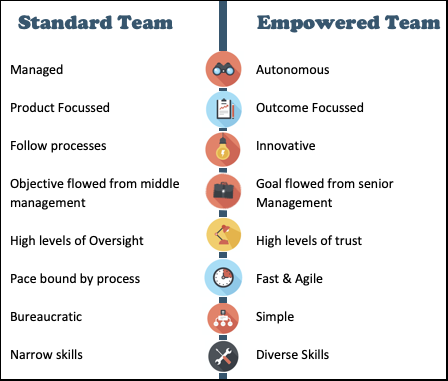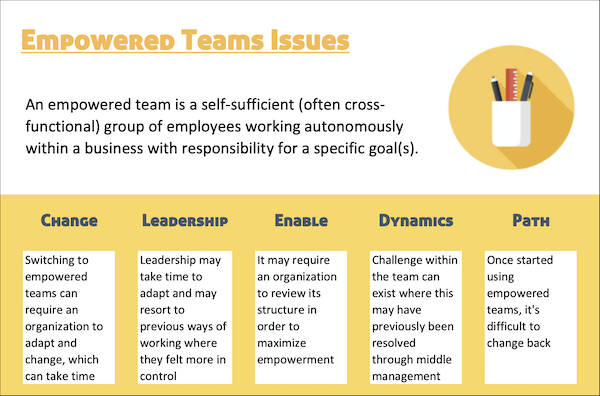
An empowered team is a self-sufficient (often cross-functional) group of employees working autonomously within a business with responsibility for a specific goal(s).
Empowered teams differ from standard teams by several factors
- They have corporate authority to enact their own decisions
- They are outcome focussed (rather than product focussed)
- They have high levels of trust and empowerment from management
In today’s article, we’ll be looking at empowered teams, what they are, how a business can use them and how they can deliver value – we’ll be looking at:
- What are empowered teams
- Characteristics of empowered teams
- Key enablers of empowered teams
- Why use empowered teams
- Where are empowered teams used
- Issues with empowered teams
- Benefits of empowered teams
What are empowered teams?
Businesses need teams to help deliver goals and objectives, whether products, services, change, or others.
Standard teams have a series of common attributes.
- They are often functional (sometimes cross-functional)
- They are accountable to middle or senior management and not autonomous
- They are tied to specific processes, policies, and governance and typically have a rigid way of working.
Businesses have realized that in order to achieve better results, with increased quality and levels of innovation, a different methodology is required.
Empowered teams are usually autonomous, innovative cross-functional (often highly skilled) groups of employees working towards a specific goal.
Whilst empowered teams take some level of direction (for example, the setting of the top-level goal), they are then entrusted to deliver as they see fit with minimal intervention from management.
As a result, the reporting chain is different to a standard team with empowered teams finding themselves reporting directly to senior management, bypassing the other levels of management completely.

There are usually four types of empowered teams.
- Project teams – multi-disciplined teams that work on a specific goal for a particular point in time
- Customer focussed teams – teams that are focused on customers
- Operational teams – focussed on day to day output.
- Problem-solving (or Tiger teams) – a type of project team that solves a particular business issue (often under time pressure).
In assessing where to use empowered teams, businesses need to first assess the problems they’re trying to solve.
Depending on the goal, the traditional approach, through their hierarchical methods, can have characteristics that are not welcome, such as
- Inefficiencies
- Lack of speed and agility
- Levels of management effort required.
- Complexity/bureaucratic
So in moving from traditional teams to empowered teams, there are clear benefits, where these challenges are solved.
However, Empowered teams bring with them their own challenges in deploying empowered teams, which you’ll need to assess when utilising them.
Perhaps the most significant aspect is cultural change. This raises itself in a few ways,
- The need for management to be more hands-off, allowing the team appropriate levels of autonomy upon which to deliver. Moving to this from an organization that is hierarchical in its nature can be difficult. Some organizations simply reinforce the message of empowerment, while others may make the more radical change of removing middle management layers in order to force the issue.
- Impact on team members: A potential impact of all this empowerment is that direct accountability may impact some individuals because they feel put under too much stress.
- Performance Management: Changes in performance management may also be required. Typical organizational performance development reviews focus on the individual’s goals, processes and performance. This runs contrary to the group mentality being deployed and is likely to need to be assessed.
Whatever the changes an organization makes, it should target changes that foster an appropriate environment in which empowered teams can perform.
Characteristics of empowered teams
So what are the characteristics of empowered teams? Here are some examples:
- Team members have the power and accountability to implement/deliver organizational goals without frequent management intervention.
- Teams are usually cross-functional and with diverse skills.
- Team construct targets the exploitation of the group’s skills.
- Senior management entrusts the team to make decisions with little governance.
- Key objectives are communicated directly by the organization’s senior management.
- The team utilizes company resources (such as information, people and training), coupled with influence and power to satisfy their customer’s needs and meet the company’s business goals.
- Empowered teams often show high levels of innovation.
Let’s consider some of the principal themes in this list
- Autonomy
- Communication
- Change
- Cross-functional skills
How a business enables these key themes will be a key decider in the success of any empowered teams that it deploys.
Key enablers of empowered teams
So now we understand the characteristics, how does a business go about enabling them? This is usually achieved via four key principles:
1/ An appropriate goal – where it is clear that an empowered team can bring benefits that support goal delivery.
2/Leadership buy-in and acceptance of empowerment principles with the result of which being authority for the team.
3/ Communication within the business regarding the role and empowerment of the team.
4/ A team with appropriate skills – It’s also worth noting that the skills required by individuals within an empowered team vs a traditional team are different. In an empowered team, team members will need to have unique skills such as assertiveness that help drive the project forward. As a result, careful selection of the team and training and support of the team must not be overlooked.
Where are empowered teams used?
Empowered teams are an organizational technique, so if you think about where you might find projects being run, then you might find empowered teams delivering them.
As a result, empowered teams are used far and wide, including
- Designing new products
- Business change
- Continuous improvement activities
Issues with empowered teams

As with any tool within a business, there are some associated issues. Empowerment shouldn’t be treated as a panacea that will cure all ills.
Some of the issues include:
- Switching from standard teams to empowered teams can require an organization to adapt and change, which can take time.
- Leadership may take time to adapt and may resort to previous ways of working where they felt more in control
- It may require an organization to review its structure in order to maximize empowerment
- Not everyone wants to be empowered, and resistance to change can occur within the team
- A Fear of change can develop within the organization
- Challenge within the team can exist where this may have previously been resolved through middle management
- Once a business has started using empowered teams, it becomes difficult to change that ethos during a project delivery if the business feels it is not working out.
Benefits of empowered teams
Let’s finally remind ourselves of some of the key benefits empowered teams can bring
- Increased effectiveness
- Innovation
- Reduced costs.
- Higher job satisfaction for those participating
- Opportunities for professional development
Summary
As we’ve seen, empowered teams differ from standard teams in a variety of ways, but they require real change within a business if they are to be effective and a mindset change from Leadership.
How does your business run its teams, is it a hierarchical method, or does it provide levels of autonomy, and if so, how successful are the results?
We’d love to hear your thoughts; you can reach us on Twitter or via the comments section below.
